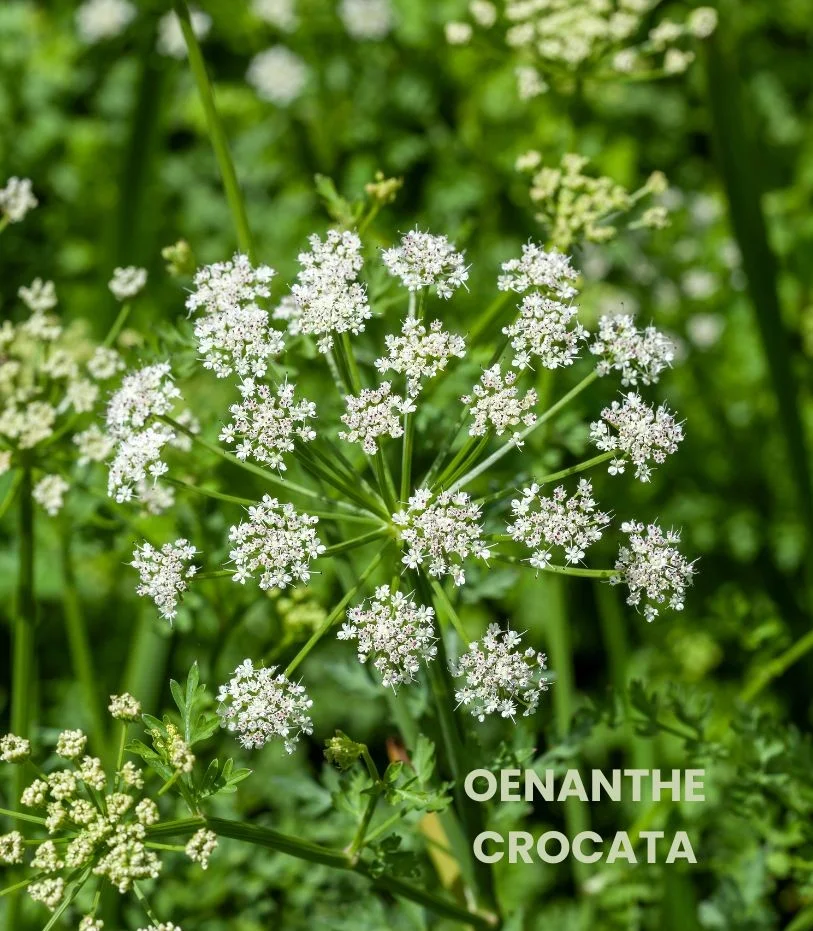Oenanthe crocata, commonly known as Water Dropwort, is a perennial herbaceous plant belonging to the Apiaceae family.
It is native to Europe and Western Asia and is characterized by its clusters of small white flowers and highly toxic properties.

Table of Contents
ToggleSOURCE INFORMATION
The homeopathic remedy Oenanthe crocata is prepared from the fresh root of the Water Dropwort plant.
The root is carefully harvested and processed according to homeopathic principles to extract its medicinal properties.
Scientific Classification
- Kingdom: Plantae
- Order: Apiales
- Family: Apiaceae
- Genus: Oenanthe
- Species: Oenanthe crocata
Origin and Interesting Facts
- Oenanthe crocata, commonly known as Water Dropwort, is a flowering plant belonging to the family Apiaceae.
- It is native to Europe and Western Asia.
- The plant grows in wet habitats such as marshes, riverbanks, and damp meadows.
- The plant typically grows up to 1.5 meters in height and has umbels of small white flowers.
- The entire plant, including the roots, stems, leaves, and flowers, contains toxic substances, particularly oenanthotoxin, which is a potent neurotoxin.
Homoeopathic preparation
- Homeopathic remedies are prepared from the fresh root of Oenanthe crocata.
- The roots are collected during the flowering season, typically in the spring and early summer when the plant is in full bloom.
- After harvesting, the roots are processed according to homeopathic methods to extract their medicinal properties.
- The process of preparing the homeopathic remedy involves extracting the medicinal properties of the fresh root through potentization, a series of dilutions and succussions.
- This process ensures that the final remedy retains the therapeutic properties of the original substance while minimizing its toxicity.
- Oenanthe crocata has a long history of use in traditional medicine for various purposes, although its toxic nature requires careful handling and preparation.
- In homeopathy, it is primarily used to treat conditions characterized by convulsions, epilepsy, and other neurological disorders.
DRUG PATHOGENESIS
- Oenanthe crocata is primarily known for its action on the nervous system, particularly causing epileptiform convulsions.
- It may also affect the respiratory system, causing spasmodic breathing and cough with frothy expectoration.
- The remedy can induce symptoms of unconsciousness, delirium, convulsive facial twitching, and trismus (lockjaw).
KEY CHARACTERISTICS
- Epileptiform convulsions: Worse during menstruation and pregnancy. Puerperal eclampsia and uraemic convulsions.
- Burning sensation in the throat and stomach, accompanied by nausea and vomiting.
- Red spots on the face, convulsive facial twitching, and numbness of the hands and feet.
- Tickling cough with rattling in the chest and thick, frothy expectoration.
- Sudden unconsciousness, furious delirium, and giddiness.
PARTICULAR ORGAN SYMPTOMS
HEAD
- Pains all over the head: The individual experiences pain that encompasses the entire head, indicating a widespread discomfort.
- Dizziness: Sensation of light-headedness or vertigo, often associated with a feeling of imbalance.
- Sudden and complete unconsciousness: Abrupt loss of consciousness, leading to a state of unawareness.
- Furious delirium and giddiness: Agitated and restless mental state, accompanied by a feeling of intense dizziness or confusion.
- Livid countenance, fixed eyes, dilated pupils: The face appears discoloured, eyes are staring without movement, and pupils are enlarged, suggesting neurological involvement.
- Convulsive twitching of facial muscles: Involuntary contractions or spasms of the muscles in the face.
- Trismus and locked jaws: Involuntary contraction of the jaw muscles, leading to difficulty in opening the mouth.
- Foaming at the mouth: Presence of frothy saliva around the lips, often associated with seizures or convulsions.
- Much yawning: Frequent involuntary opening of the mouth wide, possibly indicating exhaustion or neurological involvement.
- Tendency to cry over little things: Proneness to emotional sensitivity and tearfulness in response to minor triggers.
RESPIRATORY
- Tickling cough with rattling in the lower part of the chest: Dry, irritating cough accompanied by a sound of mucus or phlegm in the chest.
- Thick, frothy expectoration: Expulsion of thick, foamy mucus from the respiratory tract, suggestive of respiratory congestion.
- Heavy, spasmodic, stertorous breathing: Labored and noisy breathing, often with a snoring or wheezing sound, indicating airway obstruction or respiratory distress.
EXTREMITIES
- Convulsions and opisthotonos: Involuntary muscle contractions leading to arching of the body backward, suggesting severe neurological involvement.
- Pain along crural and sciatic nerves, starting in the back: Discomfort or shooting pain along the paths of the major leg nerves, originating from the lower back.
- Cold hands and feet: Decreased temperature sensation in the hands and feet, possibly due to poor circulation or neurological dysfunction.
- Numbness of hand and foot: Loss of sensation or tingling in the hands and feet, indicative of nerve dysfunction or poor blood flow.
MODALITIES
- AGGRAVATION: Symptoms are worse during menstruation and pregnancy.
- AMELIORATION: Burning sensations in the throat and stomach may be relieved by cold applications.
WHAT ARE MODALITIES IN HOMOEOPATHY?
RELATIONSHIP WITH OTHER DRUGS
DOSE
- Oenanthe crocata is typically administered in potencies ranging from the first to the sixth.
Frequently Asked Questions
What are the primary symptoms of Oenanthe crocata poisoning?
- The primary symptoms include epileptiform convulsions, burning sensations in the throat and stomach, facial twitching, and respiratory distress.
Is Oenanthe crocata safe for self-medication?
- No, due to its highly toxic nature, Oenanthe crocata should only be used under the supervision of a qualified homeopathic practitioner.
What precautions should be taken when handling Oenanthe crocata?
- Care should be taken to avoid direct contact with the plant, especially the roots, as they contain toxic compounds that can cause severe adverse reactions.
Meaning of Difficult Words
- Epileptiform: Resembling or characteristic of epilepsy, a neurological disorder characterized by recurrent seizures.
- Uraemic: Relating to or affected by uremia, a condition in which there is a buildup of waste products in the blood due to kidney dysfunction.
- Opisthotonos: A condition characterized by severe spasm of the muscles, causing backward arching of the head, neck, and spine.
- Frothy: Consisting of or resembling foam, especially when referring to expectorated material.
